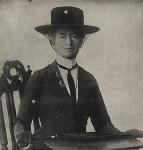Born: Established: 16 Oct 1859 Tipperary (County),
AustLit

Daisy Bates
Daisy Bates
i(A7971 works by)
(birth name:
Daisy May
O'Dwyer)
(a.k.a.
Kabbarli Bates; Kabbarli; Daisy Murant; Daisy May Bates)
Born: Established: 16 Oct 1859 Tipperary (County),
Born: Established: 16 Oct 1859 Tipperary (County),
c
Ireland,c
Western Europe,
Europe,
;
Died:
Ceased:
18 Apr 1951
Adelaide,
South Australia,
Gender:
Female
Arrived in Australia:
1884
The material on this page is available to AustLit subscribers. If you are a subscriber or are from a subscribing organisation, please log in to gain full access. To explore options for subscribing to this unique teaching, research, and publishing resource for Australian culture and storytelling, please contact us or find out more.
BiographyHistory
Most Referenced Works
Notes
-
Manuscripts held in: The State Archives of WA, Colonial Secretary's Office (Personal File); Mortlock Library, SA, (Letters 1937-49, PRG 878); LaTrobe Library, Melbourne (Correspondence and papers 1918-46); National Library (Papers MS 365); Mitchell Library (Correspondence 1910-42). The opera "The Young Kabbarli" was written by Lady Mae Casey to music by Margaret Sutherland, and the Sydney Dance Company staged Barry Moreland's dance-drama, "Daisy Bates", in 1982. According to the Oxford Companion to Australian Literature she married Edwin Henry Murrant at Charters Towers, Queensland, but left him almost immediately, marrying Bates presumably bigamously. It has been suggested that this "first husband", Murrant, may have been "Breaker" Morant (see Carnegie and Shields, In Search of Breaker Morant, 1979). Elizabeth Salter's biography (Daisy Bates, the Great White Queen of the Never-Never,1971) does not mention Murrant.
Apparently there is some controversy over her date of birth. Salter cites the date given on her marriage certificate as 1863. Ernestine Hill (Kabbarli: A Personal Memoir of Daisy Bates, 1973) says 1859.
Affiliation Notes
-
Born elsewhere; moved to SA
Last amended 22 Oct 2012 09:11:10

